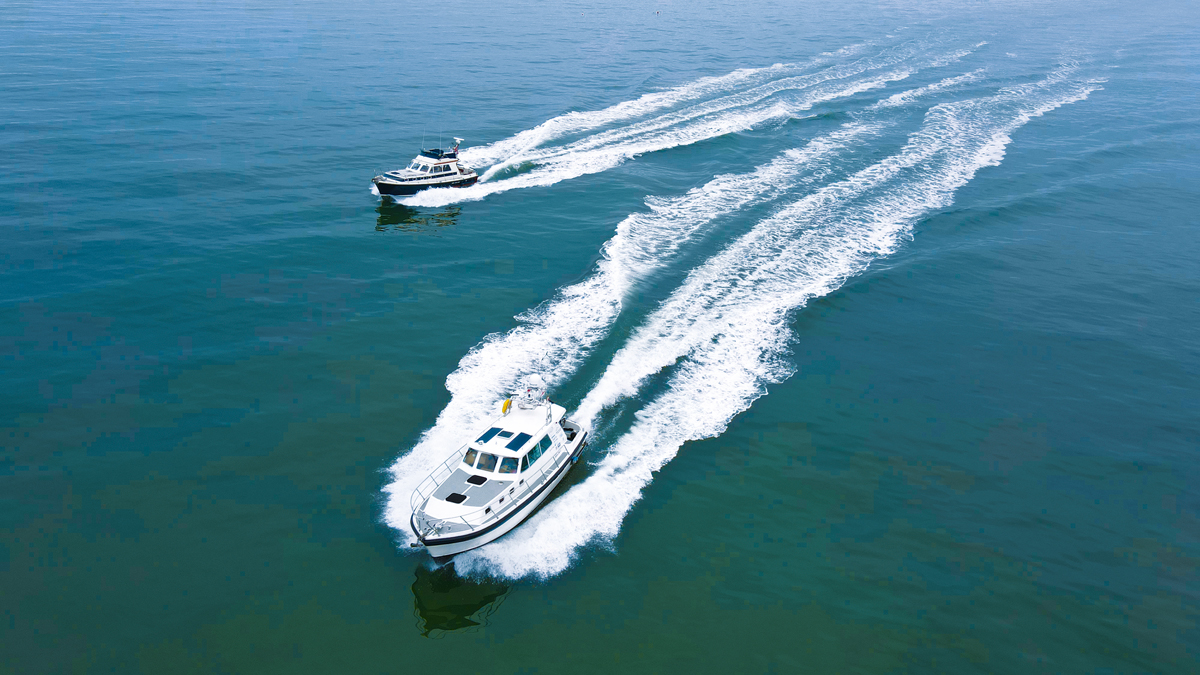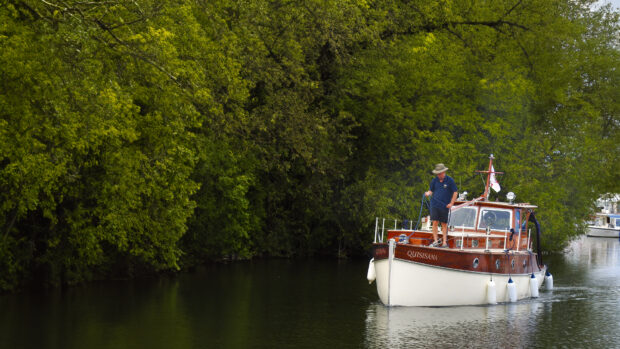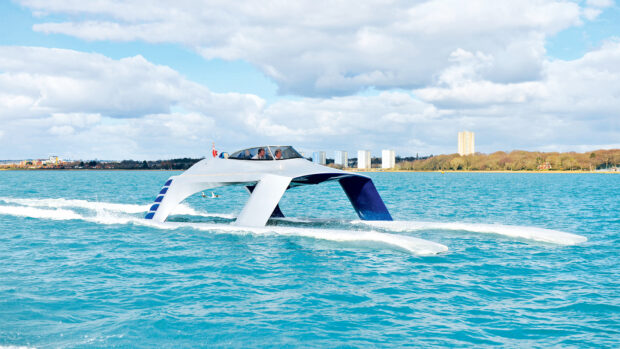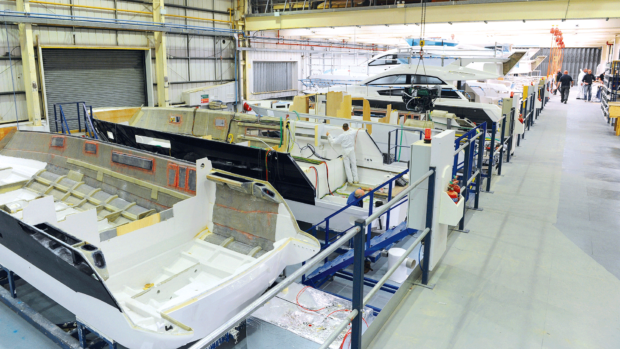Boating buddies and fellow Aquastar owners Phil Carter and Neil Cotillard push north in their attempt to circumnavigate the UK in less than a month, but there’s trouble ahead...
This is Part Two of Phil and Neil’s boating round Britain challenge – if you haven’t already, make sure to read Part One first.
27 April − Ramsgate to Lowestoft (75nm)
Two days and 225nm into our boating around Britain challenge, we’ve crossed the English Channel from Jersey and made it as far as Ramsgate. However, we’ve already had a few problems and are well aware that the hard yards lie ahead as we push on north up the exposed East Coast with 24 days and 1,700nm to go!
With a high-pressure system over Scotland and moderate north-easterly winds, we complete our engine checks and head for the fuel barge. Somehow Neil manages to get lost in the harbour and arrives several minutes after me, muttering something about the previous evening’s Calvados nightcap, but his hangover is soon forgotten when Merlin gives us a hefty discount on the fuel to support our fundraising efforts for Prostate Cancer UK.
Tanks brimmed, we batten down the hatches and head out into the complex channels of the Thames Estuary. Once past North Foreland we are soon zig-zagging through the various channels and wind farms bearing foreboding names like Knock, Sunk and Black.
After a wet couple of hours bouncing through the chop, the tide turns, allowing us to increase speed and push on towards Lowestoft. The autopilot on April Rose is still playing up, requiring me to hand steer the whole time but at least it helps me to stay focussed.
Dodging the shipping keeps us both busy and as we close on the low-lying Suffolk coastline, Sizewell nuclear power station hoves into view. At 1430 we catch sight of the huge wind generator to the north of Lowestoft harbour, which Colin assures me is the tallest on the English mainland and goes by the name of Gulliver, one of many random facts he proffers as we make our way north.
Article continues below…

Boating around Britain in 26 days: How our crazy charity challenge began

Broom 37 owners explain how they accidentally cruised from Kent to Wales
Royal Norfolk & Suffolk Yacht Club finds room for us in their small marina and once safely berthed Colin sets to work drying out the bunk on April Rose caused by a persistent leak from the deck vents. We enjoy a superb dinner in the club’s restaurant, discussing options for the next leg.
The moderate north-easterlies are set to continue for a few days so we decide to have a rest day to make repairs and explore locally. With no early wake-up calls to worry about, when the yacht club bar shuts, the gin bar on April Rose opens.
The next day dawns cold and grey but at least it’s dry and we spend the morning sealing the deck vents to try and stop the leaks. Once complete, we dig our bikes out and head off to explore Lowestoft.

The Aquastar twins rafted together in Lowestoft
We follow the inner harbour towards Oulton Broad but are soon distracted by the lure of a pint or two at the Quayside Bar in Broadlands Marina. When we get back, we refill the boats with diesel and our bodies with a fish and chips supper.
Journey time: 5hr 30min
Average speed: 13.9 knots
Approx fuel burn: 320 litres per boat
29 April − Lowestoft to Bridlington (126nm)
We leave Lowestoft just after 0800, running inside Holm Sand and Scroby Sands off Great Yarmouth. After the North Scroby cardinal we turn west towards Cockle then across the Would and its many wrecks to North Haisborough. To seaward are numerous gas rigs and wind farms.
As we cross the Wash, the wind drops away and we consider extending our passage but Neil seems keen to go into Bridlington, even though the pilot book states it’s a drying harbour. The harbourmaster says there are marina pontoons available so we stick to our plans.

Hand steering on the leg from Lowestoft to Bridlington
With a flat calm sea and a welcome sun overhead, we cross the Humber approaches, accompanied by dolphins, heading towards Bridlington. Taking advantage of the fine conditions, I reset the autopilot by completing a set of predefined manoeuvres before entering the harbour at 1700.
The local harbour seal watches as we pass the fishing fleet to port and berth on a free hammerhead. Once secure, we head into the town for a few beers and a delicious meal at Yips Chinese restaurant. It is dark by the time we return to the marina to find both our boats aground but upright in the soft mud.
With “I told you so” ringing in Neil’s ears, we retreat to our bunks. The next high water is at 0515, meaning we need to be out of here by 0700.
Journey time: 8hr 43min
Average speed: 14.5 knots
Approx fuel burn: 580 litres per boat

Afloat again in Bridlington’s drying harbour
30 April − Bridlington to Scarborough (16nm)
At 0715 we wave goodbye to the harbour seal and under a gorgeous blue sky turn towards Flamborough Head, dodging numerous pot markers as we go. Sunglasses on and throttles down, it looks like being a great day…
As we round Flamborough Head, Joie de Vivre suddenly stops and Neil comes on the VHF saying his engine is overheating. We make our way cautiously alongside. Phil has already removed the impeller, which appears intact. It’s only on closer inspection that he sees the pump shaft is still attached – it has sheared off inside the impeller.
We suspect a plug of mud from last night’s grounding may have overstressed it. Neil doesn’t have a spare pump so we decide to head in to Scarborough to source a replacement. I rig up a tow rope and bridle and we are soon under way at a steady 7 knots in mercifully calm seas.

Heading for Scarborough, before Joie de Vivre overheats
The harbourmaster advises that the tide won’t be high enough for us to enter until 1330 so I drop anchor and pull Joie de Vivre alongside. Neil calls Finning UK to see if they have a pump. No such luck and as it’s a bank holiday weekend, they can’t check the European network until Tuesday. It’s looking like a showstopper.
A few minutes later Neil’s phone rings. His mechanic in Jersey has tracked down a pump in Devon. Another call to a man with a van and the pump is on its way to Scarborough. As soon as there is sufficient water, we tow Joie de Vivre into harbour and with the harbourmaster’s help manhandle her alongside and remove the knackered pump.
At 2100 the van appears and in exchange for a wad of notes, the precious booty is ours. Within 30 minutes the pump is installed and working once again.
Journey time: 3hr
Average speed: 4.1 knots
Approx fuel burn: 40 litres per boat
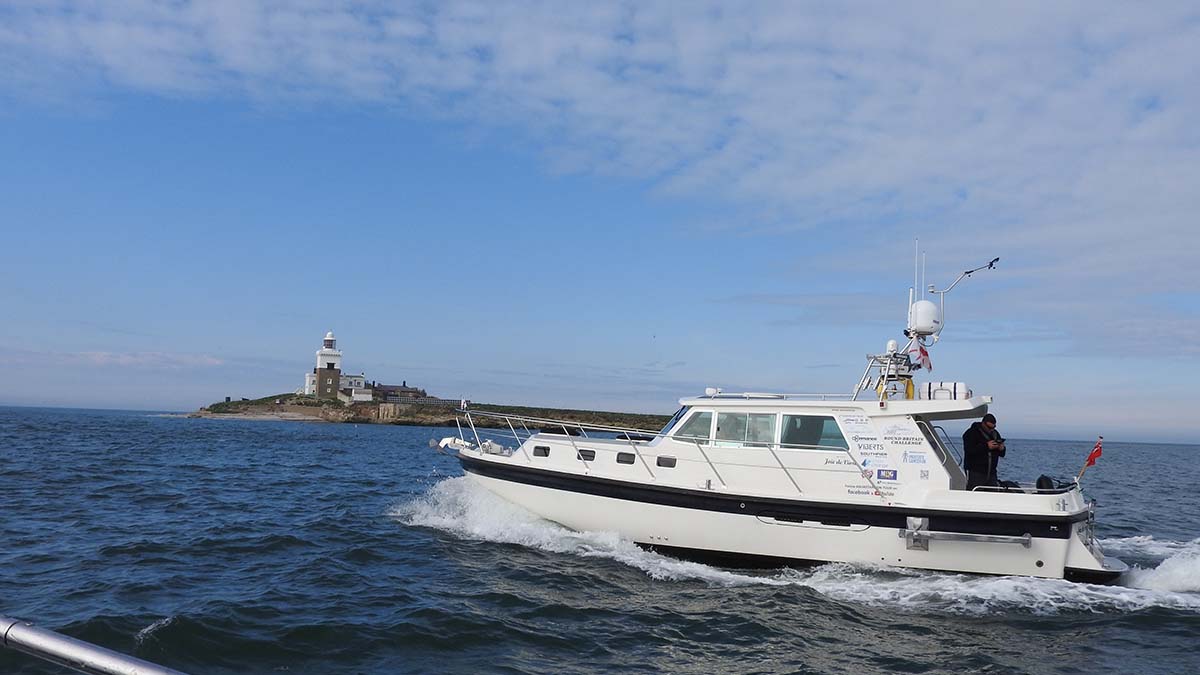
1 May − Scarborough to Amble (82nm)
We leave Scarborough at 0900 in light drizzle but calm seas. We are a day behind schedule but the light winds might let us get back on track to Amble after a fuel stop in Sunderland.
Neil keeps a close eye on his engine temperature as we motor past Whitby, dodging fishing boats and pot markers, while Colin keeps us entertained with stories about Whitby Abbey being the inspiration for Dracula’s castle.
We spot the fleet of anchored ships waiting to access Tees Port long before we see the entrance to Sunderland. Phil’s nephew works on the local pilot boat and has arranged for us to refuel at Sunderland Yacht Club.

Joie de Vivre passing Coquet Island off Amble
We weave our way through a multitude of small yachts and commercial craft to the marina entrance. After fuelling and berthing, we have just enough time for a bacon butty in the marina café with Phil’s nephew before getting under way again. We hug the coast keeping clear of the shipping as we cross the entrance to the Tyne.
As we pass St Mary’s Lighthouse my port engine starts hunting, dropping briefly down to 1,500rpm before resuming its normal 2,500rpm. My heart rate does much the same but after half an hour the issue seems to resolve itself. We run between Blyth and its wind farm aiming for Amble.
The marina is down a long channel leading to a cill at the entrance with access three hours either side of high water. There’s just enough water for us to motor straight in and
once berthed we crack open a celebratory beer.
The harbourmaster kindly waives our mooring fees in support of our charity fundraising, leading to more beers at the Cock & Bull followed by a slap-up dinner at the Taj Mahal. Buoyed by the meal, Colin and Phil head off to the karaoke bar, while Neil and I retire to bed.
Journey time: 5hr 50min
Average speed: 14 knots
Approx fuel burn: 340 litres per boat

2 May − Amble to Arbroath via Farne Islands (88nm)
We cast off at 0800 before the tide drops any further. Even in the channel there are only a couple of metres under the keel as we head out into Alnmouth Bay, slaloming through the lobster pots. Our plan is to stop for breakfast in the Farne Islands before crossing the border into Scotland en route to Arbroath where my friend Rob is due to join us.
It is only an hour’s run to Farne, passing Dunstanburgh Castle before motoring slowly through the inner sound, dodging the trip boats running back and forth, then across Farne Sound to Lindisfarne, where we tiptoe over Nob bar and drop anchor in a few metres of water.
Whilst the bacon and eggs are frying, Neil flies the drone over the island, getting some amazing footage of the seal colony on the beach. A few of the more inquisitive ones swim over to inspect these strange visitors from Jersey. Phil checks his boat’s fuel separator and drains off a worrying amount of water and gunk even though ours remain clear.

Seal colony on Lindisfarne
We leave Lindisfarne at 1100, heading out on a rising tide for the 60nm leg to Arbroath. Passing the Isle of May we are advised to alter track to avoid the foundations of a new wind farm that wasn’t yet marked on our digital charts.
Crossing St Andrews Bay, Neil and Phil spot a whale while small rafts of puffins and guillemots bob all around us. Before long we’re entering Arbroath harbour and turning to port into the locked marina. Inevitably, we are drawn towards the Commercial Inn, where we fall into conversation with the pub’s owner.
Hearing about my boat’s AIS issues, he offers to sell me the spare VHF aerial from his fishing boat which I hastily agree to. We head back to the boats for a BBQ on the back of JDV, where the usual high spirits end with dancing in the cockpit, much to the amusement of the seagulls eying up the leftover sausages.
Rob arrives at midnight just as the revelries are subsiding, wondering what he has let himself in for.
Journey time: 6hr 21min
Average speed: 13.8 knots
Approx fuel burn: 360 litres per boat

Arbroath harbour is a welcome sight after six hours
3 May − Arbroath to Peterhead (65nm)
It’s cloudy but the wind has picked up to Force 4 gusting 6. Thankfully it has also swung round to the south-east so at least it’s behind us. We decide that once the lock opens at 1300 we will poke our noses out and see what the conditions are like. The late start gives us time for sightseeing.
Neil, who has his own smokery, has arranged a tour of the famous C Lyons smokehouse where Arbroath Smokies are made from locally caught haddock. We also get a tour of the RNLI station, before joining the crew on the Mersey class lifeboat, Inchcape, for a mug of tea.
We leave as the lock opens, top up the tanks at the fuel berth and head out into the choppy sea. The following swell is uncomfortable and we hug the coast trying to pick up as much shelter as we can.

To make matters worse, the port engine starts hunting again but as it doesn’t seem to be getting any worse, we carry on surfing the waves while heading northwards. Passing Buchan Ness lighthouse and Skerry rock, we finally start to pick up shelter, allowing a more comfortable ride past the commercial docks to the small marina in Peterhead Bay.
By 1815, both boats are berthed and washed, leaving us to catch a bus into town on the other side of the harbour, where we enjoy a fine dinner at the Palace Hotel.
Journey time: 5hr 30min
Average speed: 12 knots
Approx fuel burn: 330 litres per boat
4 May − Peterhead to Wick (77nm)
We wake to sunny skies and light winds and I take the opportunity to inspect the pre-filter and see if there is anything obvious causing the revs to hunt. The bowl is clear and the filter still looks clean but I change it anyway and bleed the system through.
Phil checks JDV’s filter too and finds more water and gunk but no sign of how it got there. We leave the marina at 0930. Once past the North Head, we set course to the east of Rattray Head and put the kettle on as it is almost flat calm.
It’s 80nm or so to the Orkneys but the conditions couldn’t be better. By the time we are east of Smith Bank, the turbines of the Beatrice offshore wind farm are starting to spin. The wind has shifted to the north increasing to Force 4, sending waves crashing over our bows.
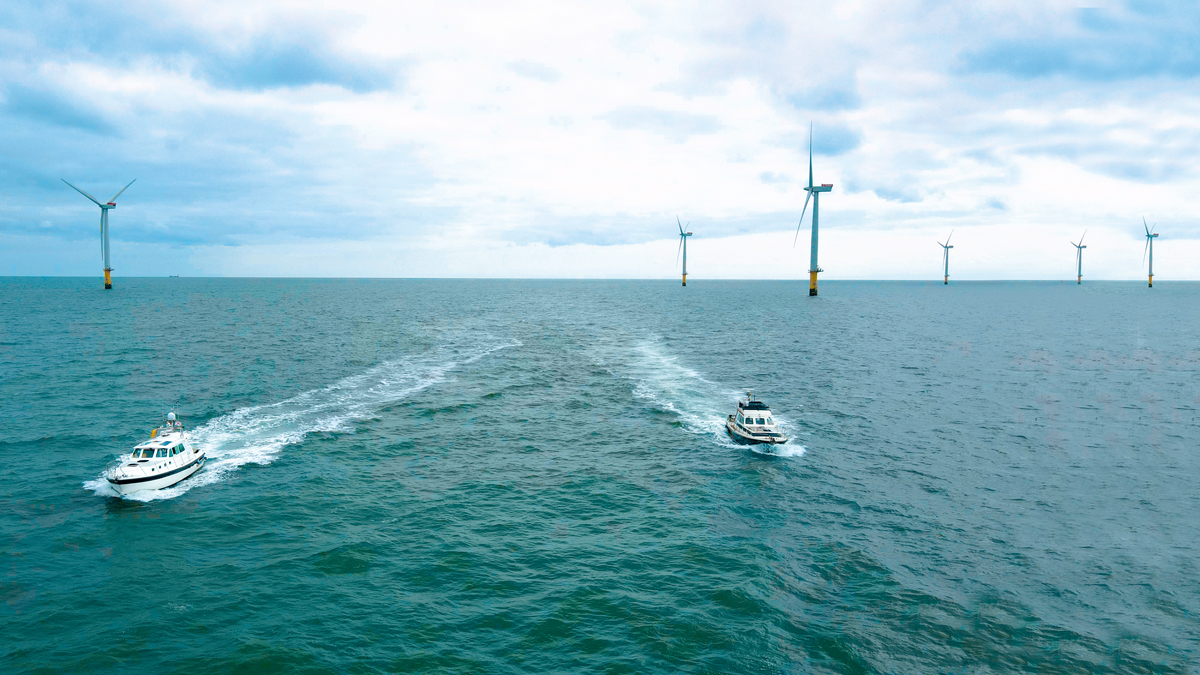
Neil has pushed ahead but I can’t summon him on the VHF radio. When I finally manage to speak to him by phone, we agree to head into Wick for lunch and see whether the wind and waves abate when the tide turns. At least the hunting on my port engine seems to be resolved.
Both the harbourmaster and the coxswain of the Wick lifeboat are there to help us onto our berth and once moored up we head ashore. Over a few pints in the Alexander Bain we swiftly agree that we aren’t going anywhere today so we can make the most of the very reasonable prices in the bar.
The forecast for tomorrow is set fair and the Orkneys are in our sights. The next morning, we have arranged to take on fuel at the commercial pumps in the River Harbour. Neil leaves first and we follow five minutes later.

Colin plans tomorrow’s route
To get to the fuel berth, we have to pass through the outer harbour into Wick Bay then turn to port aiming for the gap between the north and south river piers. Once we reach open water, I turn to port and almost immediately come to a shuddering halt with the bow pointing upwards. We have hit an underwater obstruction.
Colin, who was on the side deck at the time, is almost thrown over the side but manages to hang onto the guardrail. Tentatively, I put the engines into astern and reverse slowly off the rock. I am visibly shaking but check that Colin and Rob are alright before inspecting the bilges for any sign of water.
They are dry but there’s a 5ft length of our sacrificial hardwood keel floating alongside that has clearly taken the brunt of the collision. Gingerly, we move further into the channel but an ominous vibration is coming from the propellers. Is this the end of April Rose’s round-Britain boating adventure?
Journey time: 5hr
Average speed: 14.9 knots
Approx fuel burn: 350 litres per boat
Next month: Will our intrepid duo manage to repair the damage and get back on track before the clock runs out on their 26-day mission?
To donate to their fundraising efforts for Prostate Cancer UK visit the Aquastars on Tour GoFundMe page.


Sealing the deck vents at Lowestoft

Phil shares a joke with cousin Greg




